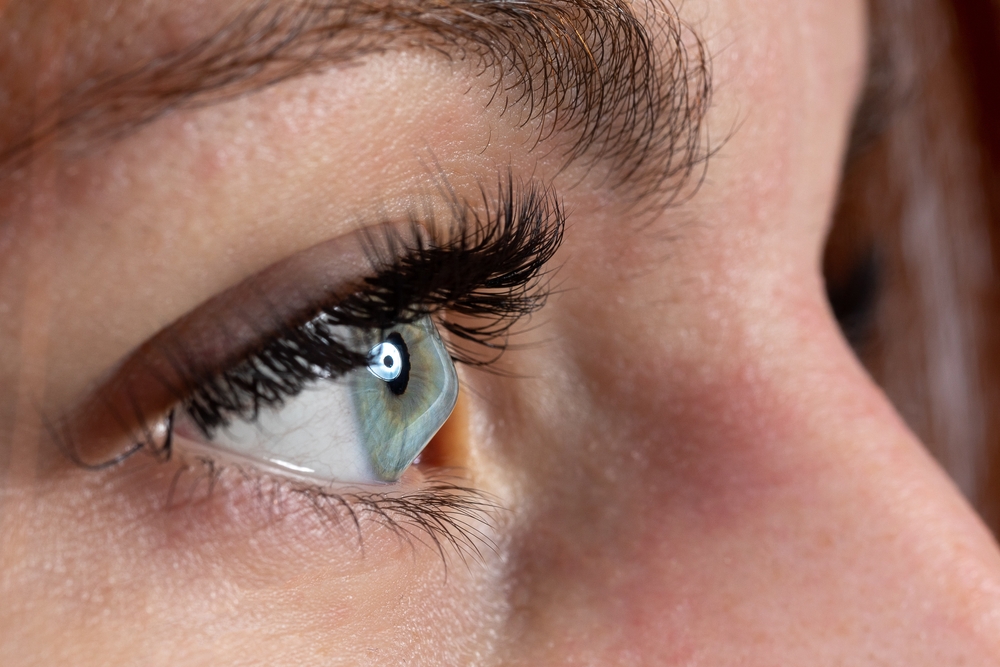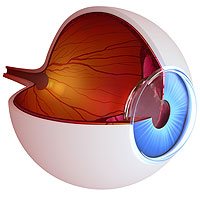Astigmatism is a refractive error that causes blurred vision whether you’re looking at an object up close or far away. If you want to reduce your dependence on glasses or contacts, LASIK can offer a more permanent solution.
Keep reading to learn more about astigmatism and how LASIK can help address it!
What is Astigmatism?

Astigmatism is a refractive error that happens when your cornea or lens is irregularly shaped. A refractive error occurs when your eye shape prevents light from bending correctly and focusing on your retina, causing blurry vision and other vision problems.
Corneal Astigmatism
In corneal astigmatism, the cornea is oddly shaped, causing a refractive error. The cornea is the transparent front part of your eye that’s typically round, like a basketball.
This shape lets light focus correctly on the retina, producing clear images. With astigmatism, the cornea is shaped more like a football.
The uneven curve causes light to not focus properly on the retina, leading to fuzzy or blurred vision at all distances—whether you’re reading the menu, using your computer, or driving.
Lenticular Astigmatism
This type of astigmatism occurs when your eye’s natural lens is misshapen, resulting in a refractive error. The lens is the clear, curved structure behind the iris or colored part of the eye.
It bends light and focuses it properly on your retina so you can see clearly.
What Causes Astigmatism?

Astigmatism can be present from birth. You may also get it after an eye surgery, eye disease, or an injury to the eye.
Although rare, a condition called keratoconus can also lead to irregular astigmatism. Keratoconus is an eye condition that affects the cornea, causing it to thin and bulge out like a cone.
While squinting, sitting too close to the TV, or reading in low light can make it more difficult for your eyes to focus, they can’t cause or worsen astigmatism. You may have astigmatism along with other refractive errors such as farsightedness or nearsightedness.
What Are Some of the Signs of Astigmatism?
Both corneal and lenticular astigmatism can cause the following symptoms:
- Eyestrain
- Squinting
- Headaches
- Eye discomfort
- Trouble seeing at night
- Blurred, fuzzy, or distorted vision at all distances
Can LASIK Fix Astigmatism?

LASIK is one of the best ways to correct corneal astigmatism permanently. Since LASIK works by changing your cornea, it can’t address lenticular astigmatism.
The FDA-approved procedure is incredibly safe, precise, and effective. LASIK utilizes cutting-edge technology to reshape your cornea so that it can be more even.
Reshaping the cornea improves how light focuses on your retina, resulting in clear vision. However, LASIK does have limits. It can only correct a certain amount of astigmatism.
If you have more astigmatism than LASIK can correct, your eye doctor may say that LASIK is not the best option for you.
Who is a Good Candidate for LASIK?
If you have astigmatism and are considering LASIK, you should also meet the following criteria to ensure the procedure is safe and effective.
- You’re eighteen years or older
- You’re in good general health
- Your eyes are healthy enough
- You’re not pregnant or nursing
- You have sufficiently thick corneas
- Your prescription hasn’t changed for at least a year
- Your prescription falls within the treatment limits of LASIK
To know for sure if you’re eligible for LASIK, see your eye doctor. Your ophthalmologist will ask about your medical history, examine your eyes, and take measurements to determine if you qualify for LASIK.
What Happens During LASIK?
During your LASIK procedure, you’ll lie on your back in a comfortable, reclining position. Numbing eye drops will then be administered so you won’t feel pain.
You may also be given a sedative to help you relax. Your LASIK surgeon will then use a special instrument to keep your eyelids open and prevent you from blinking.
Next, they will use a laser to create a thin hinged flap in the epithelium or outermost layer of the cornea. The flap will be carefully folded back, allowing your LASIK surgeon to reach the underlying layer of your cornea called the stroma.

Using a programmed laser, your LASIK surgeon will remove small amounts of corneal tissue to change the thickness and curvature of the stroma. Reshaping the stroma corrects your astigmatism.
This allows light to focus on your retina like it should, giving you crisper, clearer vision. Once completed, your LASIK surgeon will gently put the flap back into place.
The flap heals on its own without stitches. Both eyes are typically treated the same day, one eye at a time.
The procedure only takes around fifteen to thirty minutes to complete. LASIK has minimal downtime.
Most patients resume their normal routine within a day or two. However, it can take two to three months for vision to completely stabilize and eyes to fully heal.
Will I Need Glasses or Contacts after LASIK?
LASIK has very high success rates. A majority of patients achieve excellent vision after the procedure.
The procedure permanently corrects astigmatism, usually eliminating the need for prescription lenses. That said, you may still require a little help from glasses or contact lenses occasionally to read the fine print.
Fix Your Astigmatism with LASIK
You can correct your astigmatism with LASIK at Eye Care Specialists. Our experienced doctors utilize the most advanced technology in LASIK to correct astigmatism and help you attain clear vision.
Are you interested in getting LASIK for astigmatism? Schedule an appointment at Eye Care Specialist in Berwick, Bloomsburg, Dallas, Hazelton, Kingston, Nanticoke, or West Pittston, PA, today to find out if LASIK is right for you.

















